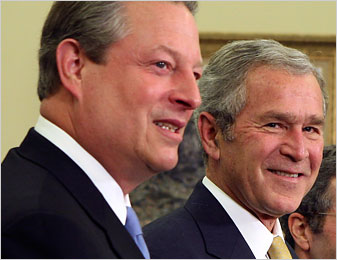Interesting arrangement/focus in the leading photo on the front page of The New York Times:

(Doug Mills/The New York Times)
Gore finds himself in front here (a little too close) and President Bush smiles, leering over his shoulder. The entire composition feels uncomfortable and, if this weren't the feeling they were going for, I'm sure the awkward photo would have ended up on the (virtual) cutting room floor.
Maybe I'm just feeling seasonal, but it seems they've chosen one of these men as the Grinch:

Wonkette offers a different shot in which GWB is somewhat less creepy.
Recent comments
2 years 29 weeks ago
2 years 44 weeks ago
2 years 44 weeks ago
2 years 50 weeks ago
3 years 4 weeks ago
3 years 4 weeks ago
3 years 4 weeks ago
3 years 6 weeks ago
3 years 6 weeks ago
3 years 6 weeks ago